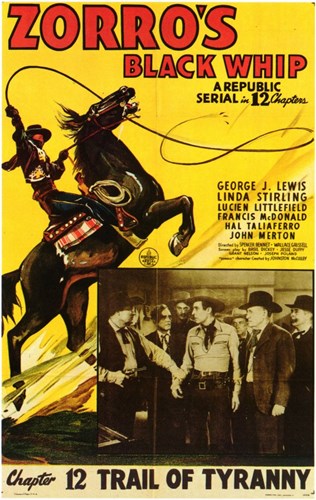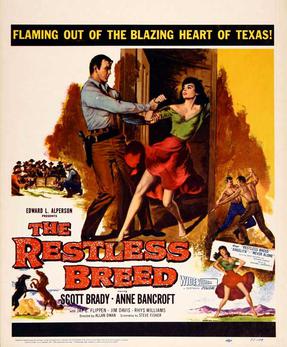
Gunfighters, also called gunslingers or in the late 19th and early 20th century gunmen, were individuals in the American Old West who gained a reputation of being dangerous with a gun and participated in shootouts. Today, the term "gunslinger" is more or less used to denote someone who is quick on the draw with a handgun, but this can also refer to those armed with rifles and shotguns. The gunfighter is also one of the most popular characters in the Western genre and has appeared in associated films, television shows, video games, and literature.
William Doolin was an American bandit outlaw and founder of the Wild Bunch, sometimes known as the Doolin-Dalton Gang. Like the earlier Dalton Gang alone, it specialized in robbing banks, trains, and stagecoaches in Arkansas, Kansas, Indiana, and Oklahoma during the 1890s.

The Rufus Buck Gang was an outlaw Native American gang whose members were Creek Indian and African American. Their crime spree took place in the Indian Territory of the Arkansas–Oklahoma area from July 30, 1895, through August 4, 1895.

East Side Kids is a 1940 film and the first in the East Side Kids film series. It is the only one not to star any of the original six Dead End Kids. The film was released by producer Sam Katzman. This was also his first project at Monogram Pictures, which he joined shortly after the folding of his company Victory Pictures.

Zorro's Black Whip is a 1944 12-chapter film serial by Republic Pictures starring Linda Stirling. The film was made after the 1940 20th Century-Fox remake of The Mark of Zorro in order to capitalize on it. Republic was not able to use the character of Zorro himself, however, and despite the title, the hero(ine) is called The Black Whip throughout.

William Larkin Stiles, better known as Billy Stiles or William Larkin, was an American outlaw in the Old West who, with partner Burt Alvord, led a small gang of train robbers while serving as a deputy sheriff in Arizona Territory.

John Franklin Dalton was a Deputy US Marshal of the Old West under Judge Isaac C. Parker, for Oklahoma Territory, as well as the older brother to the members of the Dalton Gang, in addition to being the brother to William M. Dalton, once a member of the California legislature, and later an outlaw and leader of the Doolin Dalton gang alongside Bill Doolin. Frank Dalton is not to be confused with J. Frank Dalton (1848–1951), who made many claims to be famous people, including his claim of being Frank Dalton, and later Jesse James.

In US cinema, Blaxploitation is the film subgenre of action movie derived from the exploitation film genre in the early 1970s, consequent to the combined cultural momentum of the Black civil rights movement, the black power movement, and the Black Panther Party, political and sociological circumstances that facilitated Black artists reclaiming their power of the Representation of the Black ethnic identity in the arts. The term blaxploitation is a portmanteau of the words Black and exploitation, coined by Junius Griffin, president of the Beverly Hills–Hollywood branch of the NAACP in 1972. In criticizing the Hollywood portrayal of the multiracial society of the US, Griffin said that the blaxploitation genre was "proliferating offenses" to and against the Black community, by perpetuating racist stereotypes of inherent criminality.

The Californians is a half-hour American Western television series, set during the California Gold Rush of the 1850s, which was broadcast by NBC from September 24, 1957, through August 27, 1959.

The Restless Breed is a 1957 Western film, directed by Allan Dwan and starring Scott Brady and Anne Bancroft.

Posse from Hell is a 1961 American Western film directed by Herbert Coleman and starring Audie Murphy and John Saxon.

Face of a Fugitive is a 1959 American Western film directed by Paul Wendkos. It stars Fred MacMurray, Lin McCarthy, Myrna Fahey, James Coburn and Dorothy Green and was based on the short story "Long Gone" by Peter Dawson, the pen name of Jonathan H. Glidden. Dawson was the author of 120 Western short stories and novelettes as well as 15 book length Western serials. The working title was Justice Ends with a Gun.

Don Megowan was an American actor. He played the Gill-man on land in The Creature Walks Among Us, the final part of the Creature from the Black Lagoon trilogy.

The Earth Day Special is a television special revolving around Earth Day that aired on ABC on April 22, 1990. Sponsored by Time Warner, the two-hour special featured an ensemble cast addressing concerns about pollution, deforestation, and other environmental ills.

The Gambler Wore a Gun is a 1961 Western film. The film is an uncredited remake of about five different B-westerns of the 1930s and 1940s. Some plot elements are also taken from 1954 western The Lone Gun, which starred George Montgomery.

The Man Who Died Twice is a 1958 American crime film drama, directed by Joseph Kane and written by Richard C. Sarafian. The film stars Rod Cameron, Vera Ralston, Mike Mazurki, Gerald Milton, Richard Karlan and Louis Jean Heydt. The film was released on June 6, 1958, by Republic Pictures.

Fast Bullets is a 1936 American Western film directed by Harry S. Webb and starring Tom Tyler, Rex Lease and Margaret Nearing. It was the 14th of Tom Tyler's 18 Westerns for Reliable Pictures.

Two for Texas is a 1998 American Western television film directed by Rod Hardy, written by Larry Brothers, and starring Kris Kristofferson, Scott Bairstow, Irene Bedard, Tom Skerritt, Peter Coyote, and Victor Rivers. It is based on the 1982 novel Two for Texas by James Lee Burke. The film premiered on TNT on January 18, 1998.

















